气溶胶物理与化学
- 格式:doc
- 大小:28.50 KB
- 文档页数:4
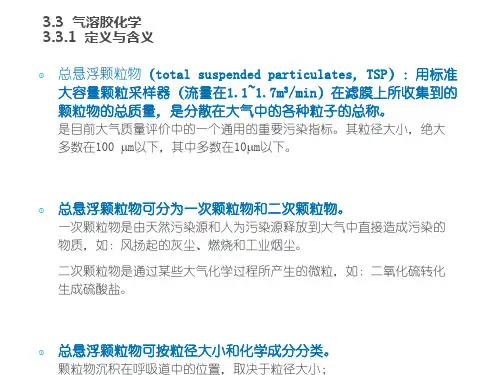
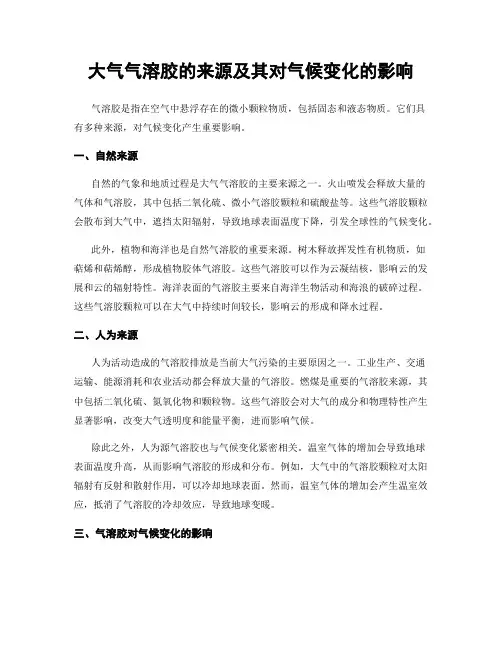
大气气溶胶的来源及其对气候变化的影响气溶胶是指在空气中悬浮存在的微小颗粒物质,包括固态和液态物质。
它们具有多种来源,对气候变化产生重要影响。
一、自然来源自然的气象和地质过程是大气气溶胶的主要来源之一。
火山喷发会释放大量的气体和气溶胶,其中包括二氧化硫、微小气溶胶颗粒和硫酸盐等。
这些气溶胶颗粒会散布到大气中,遮挡太阳辐射,导致地球表面温度下降,引发全球性的气候变化。
此外,植物和海洋也是自然气溶胶的重要来源。
树木释放挥发性有机物质,如萜烯和萜烯醇,形成植物胶体气溶胶。
这些气溶胶可以作为云凝结核,影响云的发展和云的辐射特性。
海洋表面的气溶胶主要来自海洋生物活动和海浪的破碎过程。
这些气溶胶颗粒可以在大气中持续时间较长,影响云的形成和降水过程。
二、人为来源人为活动造成的气溶胶排放是当前大气污染的主要原因之一。
工业生产、交通运输、能源消耗和农业活动都会释放大量的气溶胶。
燃煤是重要的气溶胶来源,其中包括二氧化硫、氮氧化物和颗粒物。
这些气溶胶会对大气的成分和物理特性产生显著影响,改变大气透明度和能量平衡,进而影响气候。
除此之外,人为源气溶胶也与气候变化紧密相关。
温室气体的增加会导致地球表面温度升高,从而影响气溶胶的形成和分布。
例如,大气中的气溶胶颗粒对太阳辐射有反射和散射作用,可以冷却地球表面。
然而,温室气体的增加会产生温室效应,抵消了气溶胶的冷却效应,导致地球变暖。
三、气溶胶对气候变化的影响气溶胶通过改变大气的物理和化学特性,对气候变化产生重要影响。
首先,气溶胶的反照率和散射特性会改变大气光学性质,影响太阳辐射的进入和散射。
这些过程会改变大气温度、湿度和大气环流模式,进而影响气候的变化。
其次,气溶胶直接或间接地与云的形成和性质有关。
一方面,气溶胶颗粒可以作为云凝结核,促进云的生成。
云覆盖会减少地球表面的太阳辐射,降低地面温度。
另一方面,云中的气溶胶会改变云滴的大小和分布,进而影响云的凝结和降水过程。
此外,气溶胶还可能通过影响降水量和模式改变大气和地表之间的能量平衡。
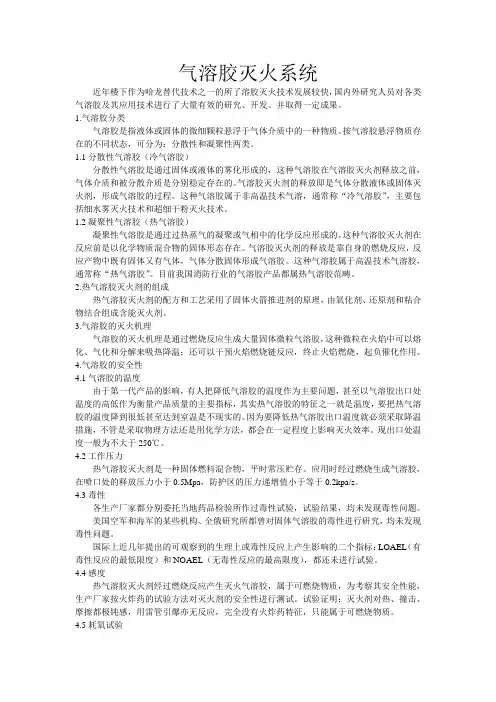
气溶胶灭火系统近年楼下作为哈龙替代技术之一的所了溶胶灭火技术发展较快,国内外研究人员对各类气溶胶及其应用技术进行了大量有效的研究、开发、并取得一定成果。
1.气溶胶分类气溶胶是指液体或固体的微细颗粒悬浮于气体介质中的一种物质。
按气溶胶悬浮物质存在的不同状态,可分为:分散性和凝聚性两类。
1.1分散性气溶胶(冷气溶胶)分散性气溶胶是通过固体或液体的雾化形成的,这种气溶胶在气溶胶灭火剂释放之前,气体介质和被分散介质是分别稳定存在的。
气溶胶灭火剂的释放即是气体分散液体或固体灭火剂,形成气溶胶的过程。
这种气溶胶属于非高温技术气溶,通常称“冷气溶胶”,主要包括细水雾灭火技术和超细干粉灭火技术。
1.2凝聚性气溶胶(热气溶胶)凝聚性气溶胶是通过过热蒸气的凝聚或气相中的化学反应形成的。
这种气溶胶灭火剂在反应前是以化学物质混合物的固体形态存在。
气溶胶灭火剂的释放是靠自身的燃烧反应,反应产物中既有固体又有气体,气体分散固体形成气溶胶。
这种气溶胶属于高温技术气溶胶,通常称“热气溶胶”。
目前我国消防行业的气溶胶产品都属热气溶胶范畴。
2.热气溶胶灭火剂的组成热气溶胶灭火剂的配方和工艺采用了固体火箭推进剂的原理,由氧化剂、还原剂和粘合物结合组成含能灭火剂。
3.气溶胶的灭火机理气溶胶的灭火机理是通过燃烧反应生成大量固体微粒气溶胶,这种微粒在火焰中可以熔化、气化和分解来吸热降温;还可以干预火焰燃烧链反应,终止火焰燃烧,起负催化作用。
4.气溶胶的安全性4.1气溶胶的温度由于第一代产品的影响,有人把降低气溶胶的温度作为主要问题,甚至以气溶胶出口处温度的高低作为衡量产品质量的主要指标,其实热气溶胶的特征之一就是温度,要把热气溶胶的温度降到很低甚至达到室温是不现实的。
因为要降低热气溶胶出口温度就必须采取降温措施,不管是采取物理方法还是用化学方法,都会在一定程度上影响灭火效率。
现出口处温度一般为不大于250℃。
4.2工作压力热气溶胶灭火剂是一种固体燃料混合物,平时常压贮存。
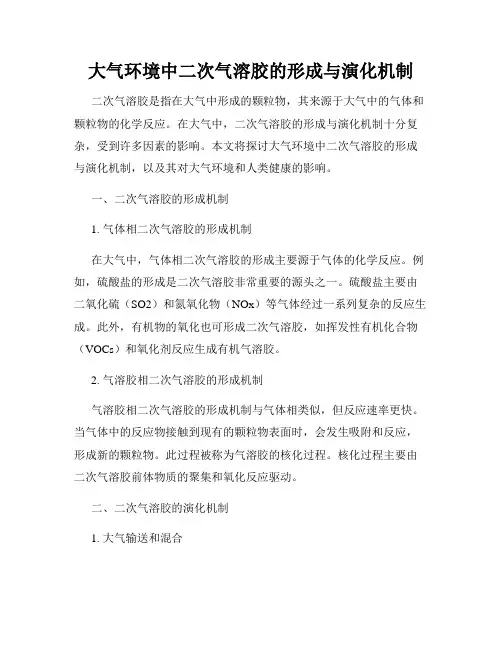
大气环境中二次气溶胶的形成与演化机制二次气溶胶是指在大气中形成的颗粒物,其来源于大气中的气体和颗粒物的化学反应。
在大气中,二次气溶胶的形成与演化机制十分复杂,受到许多因素的影响。
本文将探讨大气环境中二次气溶胶的形成与演化机制,以及其对大气环境和人类健康的影响。
一、二次气溶胶的形成机制1. 气体相二次气溶胶的形成机制在大气中,气体相二次气溶胶的形成主要源于气体的化学反应。
例如,硫酸盐的形成是二次气溶胶非常重要的源头之一。
硫酸盐主要由二氧化硫(SO2)和氮氧化物(NOx)等气体经过一系列复杂的反应生成。
此外,有机物的氧化也可形成二次气溶胶,如挥发性有机化合物(VOCs)和氧化剂反应生成有机气溶胶。
2. 气溶胶相二次气溶胶的形成机制气溶胶相二次气溶胶的形成机制与气体相类似,但反应速率更快。
当气体中的反应物接触到现有的颗粒物表面时,会发生吸附和反应,形成新的颗粒物。
此过程被称为气溶胶的核化过程。
核化过程主要由二次气溶胶前体物质的聚集和氧化反应驱动。
二、二次气溶胶的演化机制1. 大气输送和混合二次气溶胶的演化过程中,大气输送和混合起着重要的作用。
由于地理、气候和风向等因素的不同,不同地区的气溶胶浓度和组成也会有所不同。
大气输送和混合可以将气溶胶从其形成的源地输送到其他地区,并与其他气溶胶混合,从而影响其演化过程。
2. 物理和化学变化在大气中,气溶胶会受到物理和化学变化的影响,进而改变其形态和特性。
物理变化包括光化学反应、涂层形成和相变等,而化学变化则涉及物质的氧化、还原和聚合等。
这些变化会导致气溶胶的大小、形状和组成发生变化,进而影响其光学和化学特性。
三、二次气溶胶对大气环境和人类健康的影响1. 大气环境影响二次气溶胶的形成和演化过程会对大气环境产生重要影响。
首先,二次气溶胶可以改变大气辐射平衡,影响地球的能量收支。
其次,二次气溶胶对大气光学性质的改变会直接影响能见度和太阳辐射的传播。
此外,二次气溶胶还与云微物理过程紧密相连,影响着云的形成、发展和降水的过程。
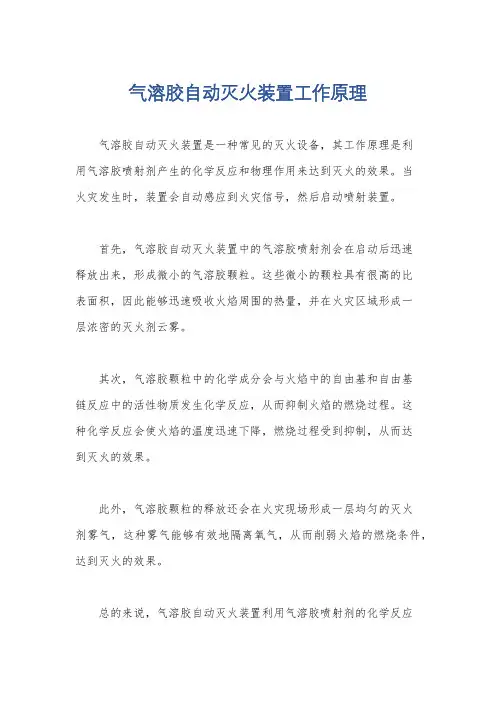
气溶胶自动灭火装置工作原理
气溶胶自动灭火装置是一种常见的灭火设备,其工作原理是利
用气溶胶喷射剂产生的化学反应和物理作用来达到灭火的效果。
当
火灾发生时,装置会自动感应到火灾信号,然后启动喷射装置。
首先,气溶胶自动灭火装置中的气溶胶喷射剂会在启动后迅速
释放出来,形成微小的气溶胶颗粒。
这些微小的颗粒具有很高的比
表面积,因此能够迅速吸收火焰周围的热量,并在火灾区域形成一
层浓密的灭火剂云雾。
其次,气溶胶颗粒中的化学成分会与火焰中的自由基和自由基
链反应中的活性物质发生化学反应,从而抑制火焰的燃烧过程。
这
种化学反应会使火焰的温度迅速下降,燃烧过程受到抑制,从而达
到灭火的效果。
此外,气溶胶颗粒的释放还会在火灾现场形成一层均匀的灭火
剂雾气,这种雾气能够有效地隔离氧气,从而削弱火焰的燃烧条件,达到灭火的效果。
总的来说,气溶胶自动灭火装置利用气溶胶喷射剂的化学反应
和物理作用,通过抑制火焰燃烧的过程和形成灭火剂雾气的方式,达到快速、有效地灭火的目的。
这种灭火装置在很多场所被广泛应用,如机房、电力设施、化工厂等,其灵敏度高、反应速度快、灭火效果好的特点使其成为一种可靠的灭火设备。
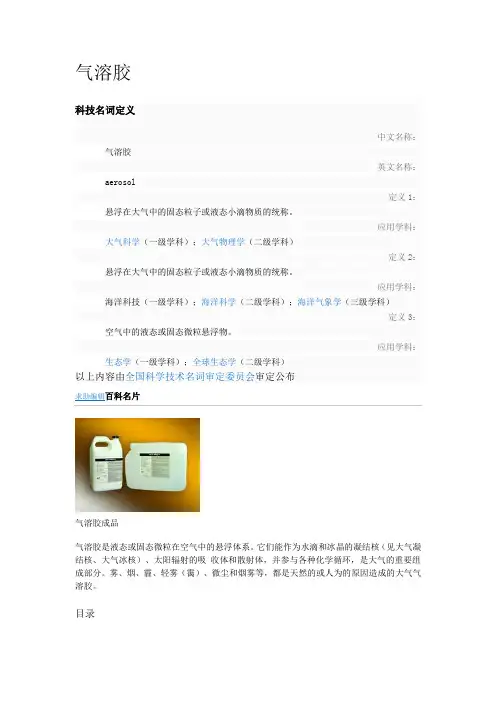
气溶胶科技名词定义中文名称:气溶胶英文名称:aerosol定义1:悬浮在大气中的固态粒子或液态小滴物质的统称。
应用学科:大气科学(一级学科);大气物理学(二级学科)定义2:悬浮在大气中的固态粒子或液态小滴物质的统称。
应用学科:海洋科技(一级学科);海洋科学(二级学科);海洋气象学(三级学科)定义3:空气中的液态或固态微粒悬浮物。
应用学科:生态学(一级学科);全球生态学(二级学科)以上内容由全国科学技术名词审定委员会审定公布气溶胶成品气溶胶是液态或固态微粒在空气中的悬浮体系。
它们能作为水滴和冰晶的凝结核(见大气凝结核、大气冰核)、太阳辐射的吸收体和散射体,并参与各种化学循环,是大气的重要组成部分。
雾、烟、霾、轻雾(霭)、微尘和烟雾等,都是天然的或人为的原因造成的大气气溶胶。
目录编辑本段一般说来,半径小于1微米的粒子,大都是由气体到微粒的成核、凝结、凝聚等过程所生成;而较大的粒子,则是由固体和液体的破裂等机械过程所形成。
它们在结构上可以是均相的,也可以是多相的。
已生成的气溶胶在大气中仍然有可能再参加大气的化学反应或物理过程。
液体气溶胶微粒一般呈球形,固体微粒则形状不规则,其半径一般为10-3~102微米。
粒径在10-1~101微米的气溶胶在大气光学、大气辐射、大气化学、大气污染和云物理学等方面具有重要作用。
小粒径气溶胶的浓度受凝聚作用所限制,而大粒子的浓度则受沉降作用所限制。
微粒在大气中沉降的过程中,受的阻力和重力的作用达到平衡时,各种粒子的沉降速度不同。
编辑本段消除气溶胶的消除,主要靠大气的降水、小粒子间的碰并、凝聚、聚合和沉降过程。
气溶胶仪器编辑本段特性科学发明莱尔·达维·古德休美国气溶胶:凡分散介质为气体的胶体物系成为气溶胶。
它们的粒子大小约在100~10000纳米之间,属于粗分散物系。
气溶胶粒子是悬浮在大气中的多种固体微粒和液体微小颗直接喷射性气溶胶仪器粒,有的来源于自然界,如火山喷发的烟尘、被风吹起的土壤微粒、海水飞溅扬入大气后而被蒸发的盐粒、细菌、微生物、植物的抱子花粉、流星自然产生的气溶胶天然气溶胶:云、雾、霭、烟、海盐等。

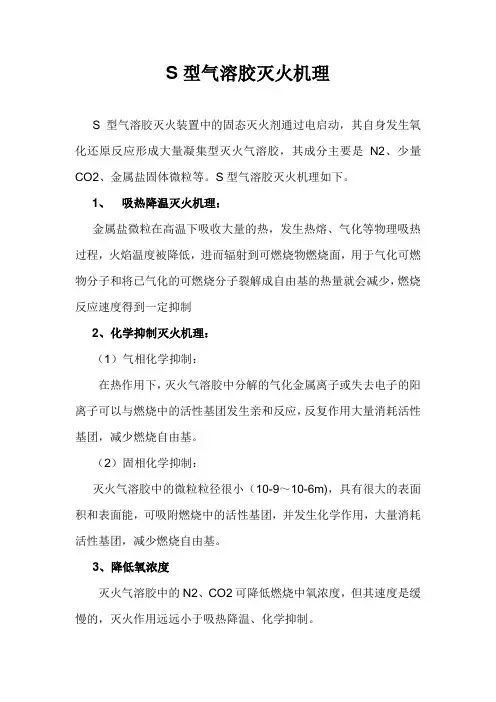
S型气溶胶灭火机理
S型气溶胶灭火装置中的固态灭火剂通过电启动,其自身发生氧化还原反应形成大量凝集型灭火气溶胶,其成分主要是N2、少量CO2、金属盐固体微粒等。
S型气溶胶灭火机理如下。
1、吸热降温灭火机理:
金属盐微粒在高温下吸收大量的热,发生热熔、气化等物理吸热过程,火焰温度被降低,进而辐射到可燃烧物燃烧面,用于气化可燃物分子和将已气化的可燃烧分子裂解成自由基的热量就会减少,燃烧反应速度得到一定抑制
2、化学抑制灭火机理:
(1)气相化学抑制:
在热作用下,灭火气溶胶中分解的气化金属离子或失去电子的阳离子可以与燃烧中的活性基团发生亲和反应,反复作用大量消耗活性基团,减少燃烧自由基。
(2)固相化学抑制:
灭火气溶胶中的微粒粒径很小(10-9~10-6m),具有很大的表面积和表面能,可吸附燃烧中的活性基团,并发生化学作用,大量消耗活性基团,减少燃烧自由基。
3、降低氧浓度
灭火气溶胶中的N2、CO2可降低燃烧中氧浓度,但其速度是缓慢的,灭火作用远远小于吸热降温、化学抑制。
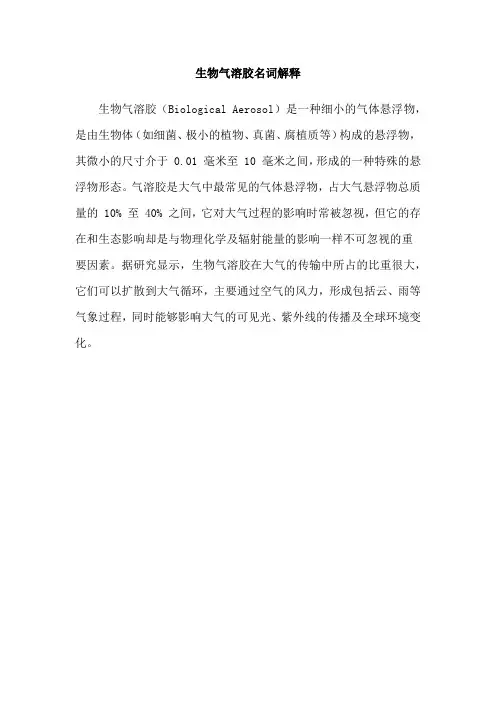
生物气溶胶名词解释
生物气溶胶(Biological Aerosol)是一种细小的气体悬浮物,是由生物体(如细菌、极小的植物、真菌、腐植质等)构成的悬浮物,其微小的尺寸介于 0.01 毫米至 10 毫米之间,形成的一种特殊的悬浮物形态。
气溶胶是大气中最常见的气体悬浮物,占大气悬浮物总质量的 10% 至 40% 之间,它对大气过程的影响时常被忽视,但它的存在和生态影响却是与物理化学及辐射能量的影响一样不可忽视的重
要因素。
据研究显示,生物气溶胶在大气的传输中所占的比重很大,它们可以扩散到大气循环,主要通过空气的风力,形成包括云、雨等气象过程,同时能够影响大气的可见光、紫外线的传播及全球环境变化。

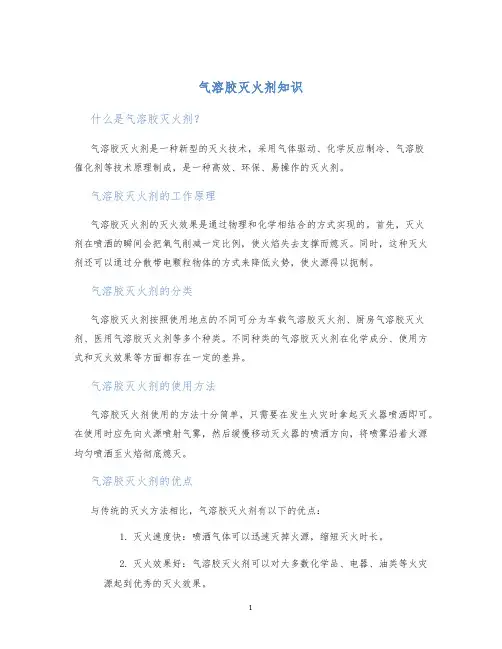
气溶胶灭火剂知识什么是气溶胶灭火剂?气溶胶灭火剂是一种新型的灭火技术,采用气体驱动、化学反应制冷、气溶胶催化剂等技术原理制成,是一种高效、环保、易操作的灭火剂。
气溶胶灭火剂的工作原理气溶胶灭火剂的灭火效果是通过物理和化学相结合的方式实现的。
首先,灭火剂在喷洒的瞬间会把氧气削减一定比例,使火焰失去支撑而熄灭。
同时,这种灭火剂还可以通过分散带电颗粒物体的方式来降低火势,使火源得以扼制。
气溶胶灭火剂的分类气溶胶灭火剂按照使用地点的不同可分为车载气溶胶灭火剂、厨房气溶胶灭火剂、医用气溶胶灭火剂等多个种类。
不同种类的气溶胶灭火剂在化学成分、使用方式和灭火效果等方面都存在一定的差异。
气溶胶灭火剂的使用方法气溶胶灭火剂使用的方法十分简单,只需要在发生火灾时拿起灭火器喷洒即可。
在使用时应先向火源喷射气雾,然后缓慢移动灭火器的喷洒方向,将喷雾沿着火源均匀喷洒至火焰彻底熄灭。
气溶胶灭火剂的优点与传统的灭火方法相比,气溶胶灭火剂有以下的优点:1.灭火速度快:喷洒气体可以迅速灭掉火源,缩短灭火时长。
2.灭火效果好:气溶胶灭火剂可以对大多数化学品、电器、油类等火灾源起到优秀的灭火效果。
3.接近无后果:化学成分偏低,使用后极少产生副作用。
4.操作简单:只需要普通的灭火器即可进行操作,易掌握。
5.环保安全:使用过程中不会产生任何有害物质。
气溶胶灭火剂的注意事项在使用气溶胶灭火剂的时候,还需要注意以下的事项:1.注意灭火器的存放位置,在平时要定期检查灭火器的有效期。
2.在使用气溶胶灭火剂时,应保持距离,避免喷射过近造成人体伤害。
3.在室内使用气溶胶灭火剂时应注意通风换气,以减少漂浮灭火剂对人体的危害。
4.正确选用适合灭火任务的气溶胶灭火剂。
结语气溶胶灭火剂是一种安全、高效的灭火手段,是防止火灾事故的重要措施之一。
但在使用过程中,也需要我们正确使用,保证其发挥最大的效果。
气溶胶的产生及其在细胞培养中的注意事项1.气溶胶定义及其产生气溶胶是液态或固态微粒在空气中的悬浮体系。
它们能作为水滴和冰晶的凝结核(见大气凝结核、大气冰核)、太阳辐射的吸收体和散射体,并参与各种化学循环,是大气的重要组成部分。
雾、烟、霾、轻雾(霭)、微尘和烟雾等,都是天然的或人为的原因造成的大气气溶胶。
一般说来,半径小于1微米的粒子,大都是由气体到微粒的成核、凝结、凝聚等过程所生成;而较大的粒子,则是由固体和液体的破裂等机械过程所形成。
它们在结构上可以是均相的,也可以是多相的。
已生成的气溶胶在大气中仍然有可能再参加大气的化学反应或物理过程。
液体气溶胶微粒一般呈球形,固体微粒则形状不规则,其半径一般为10-3~102微米。
粒径在10-1~101微米的气溶胶在大气光学、大气辐射、大气化学、大气污染和云物理学等方面具有重要作用。
小粒径气溶胶的浓度受凝聚作用所限制,而大粒子的浓度则受沉降作用所限制。
微粒在大气中沉降的过程中,受的阻力和重力的作用达到平衡时,各种粒子的沉降速度不同。
2.生物安全柜生物安全柜(Biological safety cabinets,BSCs)是利用空气净化技术,实现第一道物理隔离的技术产品,是为操作原代培养物、菌毒株以及诊断性标本等具有感染性的实验材料时,用来保护操作者本人、实验室环境以及实验材料,使其避免暴露于上述操作过程中可能产生的感染性气溶胶和溅出物而设计的。
当操作液体或半流体,例如摇动、倾注、搅拌,或将液体滴加到固体表面上或另一种液体中时,均有可能产生气溶胶。
在对琼脂板划线接种、用吸管接种细胞培养瓶、采用多道加样器将感染性试剂的混悬液转移到微量培养板中、对感染性物质进行匀浆及涡旋振荡、对感染性液体进行离心以及进行动物操作时,这些实验室操作都可能产生感染性气溶胶。
由于肉眼无法看到直径小于5μm 的气溶胶以及直径为5~100μm 的微小液滴,因此实验室工作人员通常意识不到有这样大小的颗粒在生成,并可能吸入或交叉污染工作台面的其他材料。
气溶胶污染物的形成机理和污染状况摘要:本文主要介绍有机气溶胶来源与形成的研究现状,有机气溶胶的化学组成特征。
一次有机气溶胶主要源于烹调油烟、机动车尾气、生物质燃烧、工业或民用燃油锅炉释放出的有机物,还有道路扬尘、沥青、刹车尘、轮胎屑、室外香烟烟雾、以及高等植物蜡、细菌活动和草本植物等.大气中的半挥发性有机物可通过物理和化学吸附形成二次有机气溶胶,一些挥发性有机物可通过气相化学反应转化为低挥发性的物质并形成二次有机气溶胶,其主要前体物是芳香族化合物,如苯、甲苯、二甲苯,以及烯烃、烷烃、环烷烃、萜烯和生物排放的非饱和氧化物.关键词:一次有机气溶胶二次有机气溶胶;挥发性有机物;半挥发性有机物;颗粒物;有机碳Abstract:This paperdescribes the organic aerosol sources and research status, the formation of organic aerosol chemical composition characteristic s.Once organic aerosols mainlyfrom cookingfumes, vehicle exhaust,biomass burning, industrialor commercial release of organic oil-fired boilers, as well as road dust, asphalt, brakedust, tire debris, outdoor cigarette smoke, as well as higherplantwaxes, bacterial activity andherbs, etc. semi-volatile organiccompounds in the atmosphere to formsecondary organic aerosolsthrough physical and chemical adsorption,anumber of volatile organic compoundsby gas-phasechemical reactionsinto a low volatile matterandthe formation of secondary organicaerosol, the main precursors of aromatic compounds such as benzene,toluene,xylene, and olefins, paraffins, naphthenes, and unsaturated terpene oxidesbiological emissions.Keywords:secondary organicaerosols;volatile organiccompounds ;semivolatile organiccompounds ;particle; organiccarbon有机气溶胶是大气气溶胶的重要成分,在偏远地区大约占PM10的30%~50%,在污染严重的城市地区一般占PM2. 5和PM10质量的20%~60%. 无论在污染地区还是在偏远地区,有机气溶胶都是由数百种有机化合物组成的混合物,其中很多具致癌、致畸和致突变性,如多氯联苯和其它含氯有机化合物. 它们还能够影响大气能见度,是导致大气光化学烟雾、酸沉降的重要物质,可通过长距离传输对区域和全球环境产生影响.因此,国际上非常重视大气中有机气溶胶的来源与形成机制的研究,目前主要集中在浓度和化学组分的测量、成因和来源以及产生的环境效应.随着我国经济的高速发展,我国出现了城市和区域性大气颗粒物污染现象,有机气溶胶日益成为大气污染控制的关键污染物和控制的难点.有机气溶胶的化学组成特征(Chemicalcomposition of organicaerosols) 根据目前GC2MS测量的技术水平已经鉴别出有机气溶胶含有正构烷烃、正构烷酸、正构烷醛、脂肪族二元羧酸、双萜酸、芳香族多元羧酸、多环芳烃、多环芳酮和多环芳琨、甾醇化合物、含氮化合物、规则的甾烷、五环三萜烷以及异烷烃和反异烷烃等(Mazurek et al.,1989;HHildemannet a l. ,1993;Rogge etal. , 1993e) ,表1给出了在大气颗粒物中已经被测出的以及根据光化学和热力学反应计算出的应该存在的有机物种(Saxenaetal. ,1996),但识别出的这几百种有机化合物仅占颗粒物有机质量的10% ~40% ( Seinfeld etal. , 1998).Rogge等(1993e)检测出的80多种有机化合物约占总有机物的13%,只占细粒子质量的大约2%.未鉴别出的部分包括腐殖酸、高分子量化合物、高极性化合物和不能分辨的环烷烃和支链烷烃混合物.因此,人们对有机气溶胶的化学组成、浓度水平和形成机制还了解得很不清楚大气颗粒物中的含碳物质按测量方法定义为有机碳(OC)和元素碳( EC). 有机碳是碳氢化合物及其氧化物的混合物,占有颗粒碳的大部分,既有一次源也有二次源; 元素碳本质上是一次污染物,直接由化石燃料或生物含碳物质不完全燃烧排放.元素碳在大气颗粒物中通常包裹在有机物内部,因此,很难完全区分开元素碳和有机碳. 目前,关于不同排放源OC /EC比值清单已有一些报道.Gray等(1986)建立了LosAngeles盆地的OC、EC排放清单,并建议与此有机碳相关的总有机物的质量浓度为有机碳浓度乘以1.2~1.4,因此,有机碳通常被认为是表征有机物气溶胶浓度水平的一个指标.粒径分布是大气颗粒物的重要特征,它决定了颗粒物自身的性质和环境效应. 颗粒物中某种化学组分的粒径分布特征反映出其来源,也决定了其在大气中的物理和化学行为. 颗粒物中含碳物质粒径一般分布在0.1~5μm范围(唐孝炎等,1990) ,这主要是由含碳物质的来源和形成过程所决定的.大气颗粒有机物主要分布在亚微米粒径范围内,但质量分布呈现典型的双峰态,峰值在0. 2μm和1μm左右(Pickle et al. , 1990;Mylonasetal., 1991).Offenberg等(2000)研究了5个粒径范围内( 0. 15、0.45、1. 4、4.1和12. 2μm)的含碳颗粒物,结果发现粒径在0.15~0. 45μm间的有机物占颗粒物总质量的49%,而粒径大于12μm的有机物只占3%.一次有机气溶胶的来源(Sourcesof p rimaryorganic aerosols)一次有机气溶胶的主要人为源是化石燃料和生物质的不完全燃烧,如汽油、柴油、煤、森林及草原大火、农产品残渣、木材及树叶、抽烟以及垃圾焚烧等燃烧过程的直接排放,这些过程主要释放细粒子(粒径<10μm) ;其主要的天然源是植物排放和天然大火. 另外,生物的排放,如高等植物蜡、空气中悬浮的花粉和细菌、真菌孢子等微生物,植物草木碎片和土壤有机物质的风蚀作用所产生的一次有机气溶胶,以及某些工业活动,如石油精炼、焦炭和沥青生产、轮胎橡胶的磨损等非燃烧过程排放的一次有机气溶胶,主要形成粗颗粒模态.随着人类活动的不断增加,人为源对有机气溶胶的贡献越来越大.有机碳在土壤来源、地壳贡献中一般占5%~15% ,在汽油车排放中大约占70%,在柴油车排放中大约占40% ,在居民木柴燃烧排放以及森林火灾排放中大约占50%, 在居民燃煤排放中大约占70% ,燃煤电厂排放中大约占2% ~34%,这取决于污染控制的技术水平(Chow,1995). 因此,污染源直接排放形成的有机碳因污染源类型的不同而不同.燃烧过程如生物质燃烧、机动车尾气、各种燃油、燃煤、冶炼等排放的污染物中,有机碳和元素碳一般是伴生而存在的,而道路、土壤、建筑扬尘以及湖泊底泥等非燃烧过程排放的污染物中,有机碳一般是单独存在的.燃烧过程中,燃料中的有机组分有的可能会直接排放,如VOC,有的则发生氧化、裂解,转化生成新的物质.元素碳是燃料不完全燃烧的产物,或者是有机组分裂解的产物,在大气中相对较稳定;由于燃烧源排放的有机碳和元素碳存在相伴生的特点,近年来有机碳和元素碳被用以识别含碳气溶胶的污染来源,并进行二次气溶胶判别与估算(Castroet al., 1999).烹调油烟是城市气溶胶的重要来源.肉类烹饪产生的细粒子的排放速率要高于蔬菜烹饪2~3个数量级,所有食物操作过程产生的细粒子中主要化学组成都是有机碳,在肉类操作中没有检测到元素碳,而蔬菜操作中排放的元素碳占细粒子的比例不到4%.肉类操作中排放的细粒子中主要的有机化合物为正烷酸、正烯酸,还有正烷醛和正烯醛、正烷酮、呋喃酮和胆甾醇;而蔬菜操作中主要化合物为正烷酸和正烯酸,还有少量正烷醛和正烯醛,没有检测到胆甾醇.肉类物质中的有机物在加热、光照下以及在金属和不饱和脂存在下会脱氢形成R·,这些自由基与氧反应形成过氧自由基(ROO·),过氧自由基再与其它不饱和脂反应形成RCOOH·,然后发生一系列断裂,生成大量的断裂产物如醛、酮、醇、烃、酯、呋喃和呋喃酮等(Rogge et a l.,1991).植物油和肉类脂肪中主要成分是脂肪酸甘油酯,在烹饪过程中通过水解和氧化会释放大量的十六酸和十八酸,因此,在食物烹饪操作中排放量最大的化合物为正十六烷酸、正十八烷酸、顺292十八烯酸(油酸)和顺292122十八二烯酸(亚油酸)等.胆甾醇是动物甾醇的典型代表,存在于动物脂肪中,在肉类食物烹饪过程中可以直接释放出来,未检测到其热解产物(Chow, 1995).研究表明,洛杉矶地区肉类烹调释放的有机气溶胶占一次有机气溶胶总量的21%,所检出的有机物包括烷烃、脂肪酸、不饱和脂肪酸、二元酸、壬醛、PAHs、呋喃、内脂、醇类、烯烃、类固醇、酰胺等.机动车排放是重要的颗粒有机物污染源. Rogge等(1993a)和Schauer等(1999;2002)利用台架测试指出,柴油车和无催化装置汽车的细粒子排放速率比较高,而有催化装置汽车的排放速率非常低.机动车排放的主要化学组分都是有机碳和元素碳,柴油车排放的元素碳含量明显高于汽油车排放,而有催化装置汽油车的元素碳排放要高于无催化装置汽油车;对有机碳来说,汽油车的排放要明显高于柴油车,无催化装置汽车排放的有机碳占细粒子的65%以上. 机动车排放的主要有机化合物分别为烷烃、烷酸、多环芳烃和二烯酸.20世纪80年代中期的研究结果表明,无催化装置汽车的多环芳烃排放速率最高,超过有催化装置汽车的26倍以上,而大多数正烷酸主要是由有催化装置的汽车排放的;重型柴油车具有高的正烷烃和正烷酸排放率(Roggeet al. ,1993a). 20世纪90年代中期的研究结果表明,中型柴油车排放最高量的是多环芳烃,其次为烷酸和烷烃,而无催化汽车主要排放多环芳烃和烷烃,有催化装置的汽车主要排放高分子量二元羧酸(十八碳二酸和十九碳二酸)和烷烃. 可见,机动车的类型、燃料组成和有无催化装置都会对颗粒有机物的排放量和化学组成特征有很大影响.生物质燃烧正日益受到全球关注.据统计,生物质燃烧排放的颗粒物、有机碳和元素碳分别占大气颗粒物总量的7%、39%和86%.大部分生物质燃烧是以热带草原大火和森林大火的形式发生,农田秸秆焚烧是生物质燃烧的第2种主要形式. 木柴燃烧是美国重要的细粒子污染源. 不同的地区燃烧的木柴类型是不同的,利用稀释通道采样方法,Fine等(2001;2002)研究了美国南部和东北部主要树种燃烧排放的细粒子有机物; Hays等(2002)研究了不同树叶燃烧排放的细粒子有机物;Schauer等(2001)研究了洛杉矶地区家庭取暖主要使用的木柴燃烧排放的细粒子有机物;Oros等人( 2001a;2001b)采用在污染源下风向直接采样的方法研究了不同树种野外燃烧排放的有机物. 木柴燃烧排放的有机气溶胶的组成与燃烧实验相关,壁炉实验产生的左旋葡聚糖是含量最高的有机化合物,硬木燃烧排放中第2大类物种是甲氧基酚类化合物,而软木燃烧排放的是甲氧基酚类化合物或二萜类化合物;野外实验中,硬木燃烧排放量最大的是羧酸类化合物,其次为烷烃、甲氧基酚类化合物,软木燃烧排放量最大的是二萜类化合物,其次为羧酸、甲氧基酚类化合物. 与壁炉实验相比,野外实验中左旋葡聚糖所占比例明显下降,甲氧基酚比例也下降,而二萜类和三萜类化合物比例上升. 壁炉实验和野外实验的差异来自燃烧条件的不同,壁炉燃烧时温度相对较高,燃烧比较充分,可以产生较多高温热解产物,如左旋葡聚糖; 而野外实验则采用大火和焖烧2种方式,产生较多的天然产物如羧酸、烷烃和一些二萜类化合物.研究表明,麦收季节农田秸秆焚烧对北京市区有机碳的贡献高达40% (Duan et al., 2004);美国洛杉矶地区居民木柴燃烧排放的有机物占一次有机气溶胶的14%, 冬季可达30%;丹佛地区冬季约20% ~30%的细颗粒物来自木柴燃烧(Rogge eta l. , 1998).工业或民用燃油锅炉释放出的有机物中,脂肪酸占42%~52%,苯酸占6% ~23% ,烷烃占7% ~25%,多环芳烃及其同系物占3% ~9% ,氯化物占6%~16%. 烷烃碳数范围是C19~C33,主碳数为C21、C23,可能来自油品中烷烃的直接排放或者其它化合物燃烧过程的转化.脂肪酸碳数一般小于C18, 以C16和C18为主要物种( Rogge et al.,1997b). 有机氯化物在燃油过程中可能发生热裂解,产物作为催化剂可能会促进元素碳以及多环芳烃的形成. 燃料中Cl含量的增加不仅导致PAHs浓度增加,还可能进一步产生毒性更大的有机氯化芳香化合物.城市有机气溶胶的另外一些来源包括道路扬尘、沥青、刹车尘、轮胎屑、室外香烟烟雾,以及高等植物蜡、细菌活动和草本植物等. 在轮胎屑和道路尘中,主要有机化合物为烷烃和烷酸;轮胎屑中天然树脂是很重要的组成,而刹车尘中有痕量的天然树脂(Rogge et al. , 1993b). 机动车刹车垫的磨损产生的有机物包括少量烷烃(C19~C36) 、短链脂肪酸(C6~C9)及PAH,还包括可溶性的聚烯二醇醚和三乙基乙二醇醚等.香烟烟雾中有大量的氮杂环化合物,其中尼古丁占氮杂环化合物的69%. 植物碎屑中,含量最高的化合物类别是正烷烃,其次为正烷醛和正烷醇二次有机气溶胶形成机制( Formationmechanismof secondary organic aerosols) 二次有机气溶胶的形成是指气相中的有机气体氧化形成的低挥发性产物在粒子表面的浓缩、吸附,即挥发性有机物被氧化成半挥发性有机物和半挥发性有机物分配到颗粒相.形成的二次有机气溶胶大多存在于粒径小于2μm的细颗粒物中.挥发性有机物从气相到颗粒相的转化主要有3种机制( Pandis et al.,1992; Pankow, 1994). 第一,可挥发有机物在浓度超过饱和蒸汽压时,低饱和蒸气压的有机物凝结在颗粒物上形成二次气溶胶;第二,气态有机物在颗粒物表面以物理或化学过程吸附或吸收在颗粒物的内部,此过程可发生在亚饱和状态(L igockiet al.,1989; Pankow,1987) ;第三,气态有机物在大气环境中发生氧化生成低挥发性物质,进而生成二次颗粒物.光化学烟雾是形成二次气溶胶的重要途径,其主要产物为有机硝酸脂和复杂有机化合物. 天然源和人为源有机气体均可形成二次有机气溶胶.半挥发性有机物通过物理和化学吸附可形成二次有机气溶胶. 通常将饱和蒸汽压低于临界蒸汽压4000Pa的物质称为半挥发性物质. 由于蒸汽压的限制,并不是所有存在于大气中的VOCs都能形成大气气溶胶. 一般认为,6个碳以下的烷烃(甲烷到正己烷异构体) 、6个碳以下的烯烃(乙烯到己烯异构体) 、苯以及低分子量的羧基化合物等都不能产生有机颗粒物. 半挥发性有机物存在于气态,直到其浓度达到某个临界值时,吸附到合适的颗粒物表面或通过均相成核进入颗粒态,此时,半挥发性有机物在气相与颗粒相之间便达到热力学平衡. 可用Langmuir等温吸附理论定量描述大气中有机物的气固分配,有学者认为,颗粒物对有机物的吸附是由有机物的蒸汽压和颗粒物的表面积控制( Pankow,1994). 但有机物究竟是吸附在类似于液体有机膜的颗粒物表面上,还是吸附在颗粒表面的活性点上,或是二者的混合吸附,目前还没有结论. 但已经清楚的是,不同来源的颗粒物有不同的吸附特性,湿度对吸附有影响,可用化合物的液相蒸汽压或辛醇2空气分配系数描述化合物间的差异和温度的影响.大气环境中的气态有机物可通过气相化学反应转化为低挥发性的物质并形成二次有机气溶胶.一定条件下,大气反应的产物也可以发生成核过程而产生新的颗粒物,例如萜烯与臭氧反应的产物(Kamens etal. , 1999).气态有机物在大气环境中还可通过颗粒物上的异相反应形成二次颗粒物.气相反应产物进入颗粒相后,将与气态氧化剂发生进一步反应生成另一代产物;通常,酸类对这些异相将起到催化作用,主要的催化剂有硫酸和硝酸.这些酸催化反应包括水合作用、聚合作用、半缩醛和缩醛反应、醇醛缩合.形成二次有机气溶胶的有机前体物种类很多,如烷烃、烯烃、芳香烃和酚类等,它们主要来自人为源如化石燃料燃烧、生物质燃烧、有机溶剂的使用,以及自然源如植物排放、海洋源等. 已有研究表明,形成二次有机气溶胶的主要前体物是芳香族化合物如苯、甲苯、二甲苯,以及烯烃、烷烃、环烷烃、萜烯和生物排放的非饱和氧化物.据估计,城市二次气溶胶的50% ~70%是来自甲苯、二甲苯、三甲苯等化合物. 树木等植被排放的天然源碳氢化合物也是二次有机气溶胶的重要前体物,包括萜烯(α-蒎烯、β- 蒎烯、柠檬烯)和倍萜烯,还有异戊二烯.二次有机气溶胶形成的通常只有碳数在7以上的有机物才能生成二次颗粒物(Fostner et al., 1997; Limbeck etal. ,1999;Holes et a l. , 1997;Blando et al. , 1998).有机前体物的氧化包括气相和液相氧化2个途径, 主要的气态氧化剂是臭氧、OH- 和NO-3(Grosjean et a l.,1989; Odum et a l.,1996;Griffin etal. ,1999),它们均是光化学反应的产物. 有机前体物通过氧化反应生成的产物可能包括脂肪酸、二元羧酸、醇类以及醛类等,它们通常具有较高的极性和分子量,从而减小其挥发性. 而且,这些化合物主要是中间产物,需要继续氧化成半挥发性组分才能进入颗粒态. 在一定的条件下,大气反应的产物也可以发生成核过程而产生新的颗粒物,例如萜烯与臭氧反应的产物.近年的研究表明,不少VO Cs可能在云或雾滴中通过液相氧化反应生成二次有机气溶胶. 液相氧化反应包括VOCs等有机前体物溶于液滴,随后被氧化成半挥发性有机物. 一般而言,污染源尤其是人为污染源所释放的VOCs多数难溶于水.经过气相氧化反应生成溶解性较强的脂肪酸、二元羧酸、醇类以及醛类等化合物,进而可以溶于雾滴中参与液相氧化反应.Blando等(1998;2000)发现,云水雾滴中确实存在脂肪酸、二元羧酸、醇类以及醛类等化合物. 这些化合物大多既存在于气态,又存在于液态,说明可溶性VOC参与云水或雾滴反应是可能的.Aumount等(2000)认为,云水中的高浓度有机酸主要来自液相氧化反应.二次有机气溶胶形成的另一个步骤包括凝结、吸收和吸附等途径. 凝结是最简单的气粒转化物理过程,不涉及VOC与气溶胶粒子之间的相互作用,可称为均相成核过程,类似于无机二次气溶胶如硫酸盐的形成. 早期研究认为,该过程是其气2粒转化的主要过程.然而,近期一些研究表明,异相成核过程即VOCs在气溶胶颗粒上的吸收或吸附过程,才是气粒转化的主导过程(Odum et al.,1996;1997a;1997b). 与前者比较,异相成核过程既取决于VOCs的性质,又与作为吸附点的气溶胶颗粒有关. Odum等(1996)通过烟雾箱模拟实验表明,气溶胶的量与有机气溶胶质量浓度密切相关,认为吸收或吸附过程是气粒转化的主导过程,因为凝结过程是不依赖于有机气溶胶浓度. 在气粒转化过程中吸收与吸附究竟哪个更为重要,目前尚无定论.仅有研究表明,对城市气溶胶而言,吸收过程的重要性大于吸附过程(Liang etal.,1997; Goss et al., 1998).展望( Perspective)有机气溶胶的来源与形成日益受到科学家的广泛关注,其研究方向主要集中于大气中有机气溶胶的化学组成与浓度水平、天然和人为源一次排放有机物的物理化学特征、二次有机气溶胶形成的物理与化学过程、大气中有机气溶胶的来源识别以及有机气溶胶的环境影响.为了完成这些研究和使其获得的信息更加准确,需要不断完善或开发有机气溶胶的采样技术和有机物种的检测技术.由于有机气溶胶是由多种有机物混合而成的细颗粒,而且某些有机物种的浓度水平较低,不同物种的挥发性、热稳定性等也存在较大差异,使得无论是环境空气还是污染源的有机气溶胶采集均较为困难,目前的采集方法对于有机物分析具有较大的不确定性. 因此,采样技术的研发十分重要.有机气溶胶的总体污染水平目前是通过碳分析获得的OC、EC浓度定量描述,其中,有机物种的定性和定量是采用GC/MS方法测量,但该方法也仅仅能将10%~15%的气溶胶有机物解析为特定的有机化合物(Rogge et al. ,1993e) ,对极性、强极性有机物的分析尚存在局限性.近年来,化学衍生法被广泛应用于分析极性有机物,但也只能检测很少一部分极性有机物质. 可见,有机气溶胶的采样技术和有机组分的分析检测技术是有机气溶胶领域研究的重要方向.目前还不十分清楚二次有机气溶胶的形成机理,未能很好地认识二次有机气溶胶的反应动力学,而且也未能鉴别出大量的反应物,而只能用烟雾箱实验的结果经验推测和应用数学模式模拟计算有机颗粒的形成. 在测量和模拟挥发性有机物形成有机颗粒物的动力学和热力学方面,还应用了大量的经验估计. 因此,目前人们对二次有机气溶胶形成机制的认识还较为浅薄,这仍将是今后研究的重点与热点.此外,环境空气中有机气溶胶有机组分的污染特征与来源识别的研究也是非常重要的研究方向,这对于研究有机气溶胶对人体健康、气候、能见度的影响以及与大气氧化剂反应形成的二次有机气溶胶都具有非常重要的意义.。
课程名称:气溶胶物理与化学
Title: Aerosol physics and chemistry
课程编号:070602C02
Course Number: 070602C02
课程类型:专业必修课
Course Type:Required major course
学时:60
Units: 60 hours
学分:3
Credit:3
实用专业:大气物理和大气环境研究生
Designed for: Atmospheric physics and Atmospheric Environment
教学目的:本课程的目的是使学生了解有关气溶胶的物理和化学特性以及一些基本测量方法。
Objectives: The course is designed to make student understanding the physical and chemical principles of aerosol and instruments used to measure them.
对选课学生的要求:要求学生具有普通物理学和大气化学的基础知识。
Prerequisites: The student should have a good background in chemistry and physics and understands the concept of calculus.
主要内容:
Major Contents:
气溶胶对大气能见度、气候变化以及人类健康等有重要影响。
本课程论述了大气气溶胶的基本特征和测量方法。
主要内容包括气溶胶的排放和分布、布朗运动和扩散、碰并凝结和蒸发过程、电学和光学特性、气溶胶测量、干湿沉降、气溶胶化学以及气溶胶气候效应。
Aerosol particles affect visibility, climate, and our health and quality of life. This course covers the properties, behavior, and measurement of aerosol. The major contents include the emission and distribution of aerosol, Brownian motion and diffusion, coagulation, condensation and evaporation, electrical properties, optical properties, measurement of concentration, dry and wet deposition, aerosol chemistry, and climate effect of aerosol.
第一章绪论
Chapter 1 : Introduction
第二章大气气溶胶的排放与分布
Chapter 2: The Emission and Distribution of Atmospheric Aerosol
2.1 Properties of Size Distributions
2.2 Moment Averages
2.3 Weighted Distributions
2.4 The Lognormal Distribution
2.5 Log-Probablity Graphs
2.6 The Hatch-Choate Conversion Equation
2.7 Statistical Accuracy
第三章气溶胶运动
Chapter 3:Uniform Particle Motion
3.1 Newton’s Resistance Law
3.2 Stokes’s Law
3.3 Settling Velosity and Mechanical Mobility
3.4 Slip Correction Factor
3.5 Nonspherical particles
3.6 Aerodynamic Diameter
3.7 Settling at High Reynolds Number
3.8 Relaxation Time
3.9 Stopping Distance
第四章布朗运动与扩散
Chapter 4: Brownian Motion and Diffusion
4.1 Diffusion Coefficient
4.2 Particle Mean Free Path
4.3 Brownian Displacement
4.4 Deposition by Diffusion
4.5 Diffusion Batteries
第五章碰并,凝结与蒸发
Chapter 5: Coagulation, condensation and evaporation 5.1 Simple Monodisperse Coagulation
5.2 Polydisperse Coagulation
5.3 Kinematic Coagulation
5.4 Definitions
5.5 Kelvin Effect
5.6 Homogeneous Nucleation
5.7 Nucleated Nucleation
5.8 Condensation Nuclei Nucleation
5.9 Evaporation
第六章气溶胶电学与光学性质
Chapter 6: Electrical and optical properties of aerosol 6.1 Eletric Fields
6.2 Electrical Mobility
6.3 Charging Mechanisms
6.4 Equilibrium Charge Distribution
6.5 Definitions
6.6 Extinction
6.7 Scattering
6.8 Visibility
6.9 Optical Measurement of Aerosol
第七章气溶胶浓度测量
Chapter7: Measurement of concentration
7.1 Isokinetic Sampling
7.2 Sampling from Still Air
7.3 Gravimetric Analysis
7.4 Measurement of Number Concentration
第八章气溶胶气候效应
Chapter 8: Climate effect of aerosol.
8.1 Radiative Forcing
8.2 Direct Climate Effect of Aerosol
8.3 Indirect Climate Effect of Aerosol
教学方法:
Ways of Instruction:
课堂教学,文献阅读,课堂讨论,测试练习,读书报告
Course teaching, Paper reading, Class discussing, Exercise practicing, Report writing
教材及参考文献:
Textbooks and References:
章澄昌,大气气溶胶教程,气象出版社,1995
Zhang Chenchang,‘Course of Study Atmospheric Aerosol’,
William C.Hinds,气溶胶技术,1982
William C.Hinds,‘Aerosol Technology’,1982
任课教师:刘红年
Instructor: Liu Hongnian
考核方式:课堂汇报(20%),课堂测试(30%),读书报告(50%) Course Evaluation: Presentation(20%),Test(30%),Report(50%)
大纲撰写人:刘红年
Program Designer: Liu Hongnian。